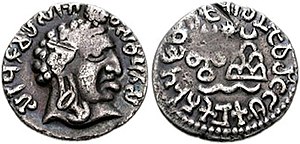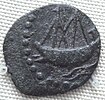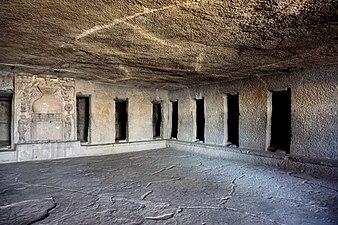Vasishthiputra Pulumavi (Brahmi: 𑀯𑀸𑀲𑀺𑀣𑀺𑀧𑀼𑀢 𑀧𑀼𑀎𑀼𑀫𑀸𑀯𑀺, Vāsiṭhiputa Puḷumāvi, IAST: Vāsiṣṭhiputra Śrī Pulumāvi) was a Satavahana king, and the son of Gautamiputra Satakarni.[5] The new consensus for his reign is c. 85-125 CE,[6][7][8] although it was earlier dated variously: 110–138 CE[9] or 130–159 CE.[10] He is also referred to as Vasishthiputra Sri Pulumavi. Ptolemy, the second century writer, refers to Pulumavi as Siriptolemaios, a contemporary of the Western satrap, Chastana.[11]
| Vasishthiputra Pulumavi | |
|---|---|
  Bilingual coinage of Sri Vasishthiputra Pulumavi in Prakrit and Dravidian, and transcription of the obverse Prakrit legend. Obverse: Portrait of the king. Legend in Prakrit in the Brahmi script (starting at 12 o'clock): 𑀭𑀜𑁄 𑀯𑀸𑀲𑀺𑀣𑀺𑀧𑀼𑀢𑀲 𑀲𑀺𑀭𑀺 𑀧𑀼𑀎𑀼𑀫𑀸𑀯𑀺𑀲 Raño Vāsiṭhiputasa Siri-Puḷumāvisa "Of King Lord Pulumavi, son of Vasishthi" Reverse: Ujjain and arched-hill symbols. Legend in Dravidian (close to Telugu and Tamil),[1] and the Dravidian script,[1] similar to the Brahmi script[2] (starting at 12 o'clock): 𑀅𑀭𑀳𑀡𑀓𑀼 𑀯𑀸𑀳𑀺𑀣𑀺 𑀫𑀸𑀓𑀡𑀓𑀼 𑀢𑀺𑀭𑀼 𑀧𑀼𑀮𑀼𑀫𑀸𑀯𑀺𑀓𑀼 Arahaṇaku Vāhitti Mākaṇaku Tiru Pulumāviku[3] or: Aracanaku Vācitti Makaṇaku Tiru Pulumāviku[4] "Of King Tiru Pulumavi, son of Vasishthi"[2] | |
| Satavahana King | |
| Reign | c. 85–125 CE |
| Predecessor | Gautamiputra Satakarni |
| Successor | Vashishtiputra Satakarni |
| Dynasty | Satavahana |
| Father | Gautamiputra Satakarni |
The capital of Sri Pulumavi is reported to have been at Paithan.[12]
Coinage
Some of the lead coins of Pulumavi depict two-masted Indian ships, a testimony to the seafaring and trading capabilities of the Satavahanas during the 1st-2nd century CE. During his rule, Gautami Balasri, the mother of Gautamiputra Satakarni, laid an inscription at Nashik. Pulumavi was succeeded by his younger brother Vashishtiputra Satakarni.[13]
- Indian ship on lead coin of Vasishthiputra Pulumavi.
Nashik Pandavleni Caves
Near Nashik, Cave No.3 of Pandavleni Caves was built by Queen Gotami Balasiri during the reign of Pulumavi, and also received a dedication by Sri Pulumavi himself. The cave was dedicated to the Samgha.[14] Based on inscription no. 3, the mountain on which the caves are present was known as Mount Tiranhu during the time of Sri Pulumavi and the area around Nashik caves was known as Sudasana, which was a part of district/province known as Govardhana.
| Cave No.3, Pandavleni Caves | |
One long inscription (inscription No.2) in the 19th year of Satavahana king Sri Pulumavi (2nd century CE), explaining that Queen Gotami Balasiri, mother of glorious king Gotamiputra, caused this cave to be built and gave it to the Samgha.[14] There is also another long inscription (inscription No.3) by Sri Pulumavi himself, also in the 22nd year of his reign.[14]
| |
| Inscription of Sri-Pulumavi Nasik Cave No.3, inscription No.3 (reign of Sri Pulumavi) | |
| |
Karla caves inscription
On the lintel to the left of the main entrance to the Great Chaitya at Karla Caves, facing the inscription of Nahapana and posterior to it by a generation, there is also an inscription by Satavahana ruler Sri Pulumayi, that is, Vasishthiputra Pulumavi:[16]
In the seventh year of the king Sri Pulamavi, son of Vasithi, in the fifth fortnight of summer, on the first day, on the above, by the Maharathi Somadeva son of Vasithi, the son of the Maharathi Mitradeva son of Kosiki, of the Okhalakiyas, there was given to the community of Valuraka, of the Valuraka caves, a village with its taxes ordinary and extraordinary, with its income fixed or proportional.
References
Rao (1994), History and Culture of Andhra Pradesh: From the Earliest times to the present day, Sterling publishers, ISBN 81-207-1719-8










